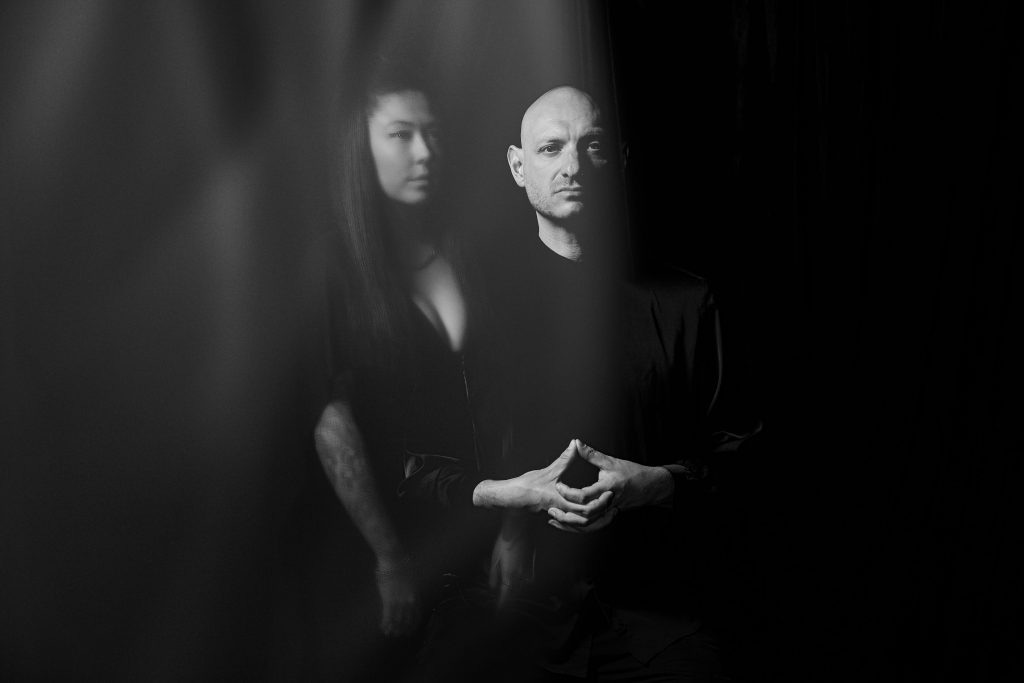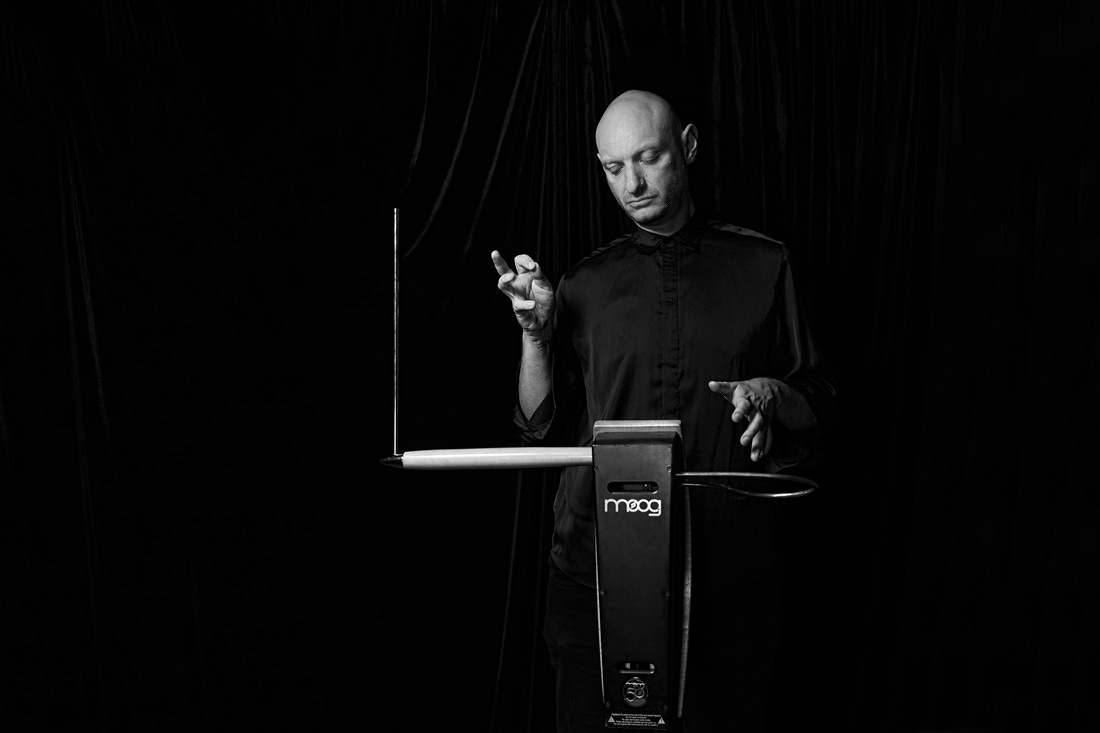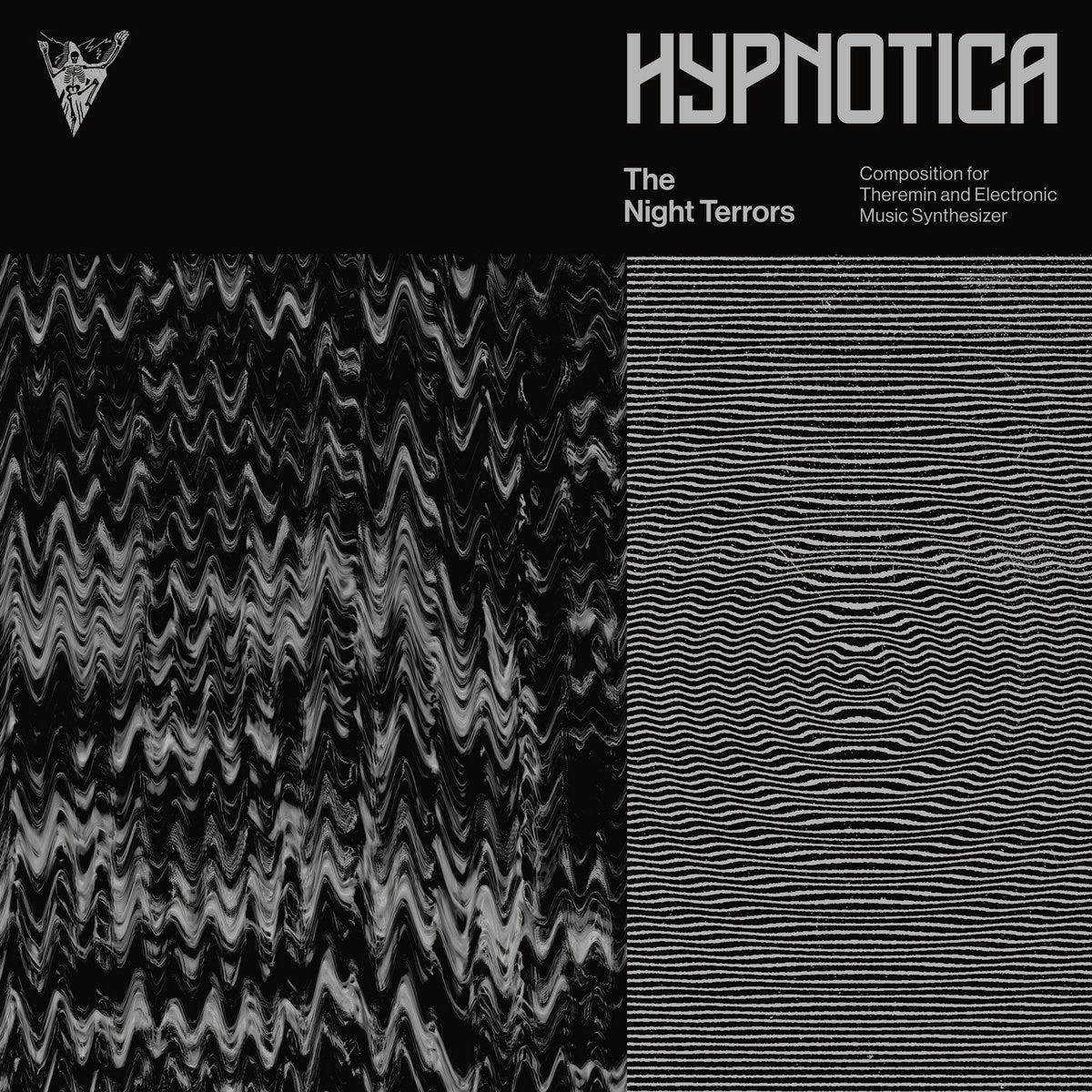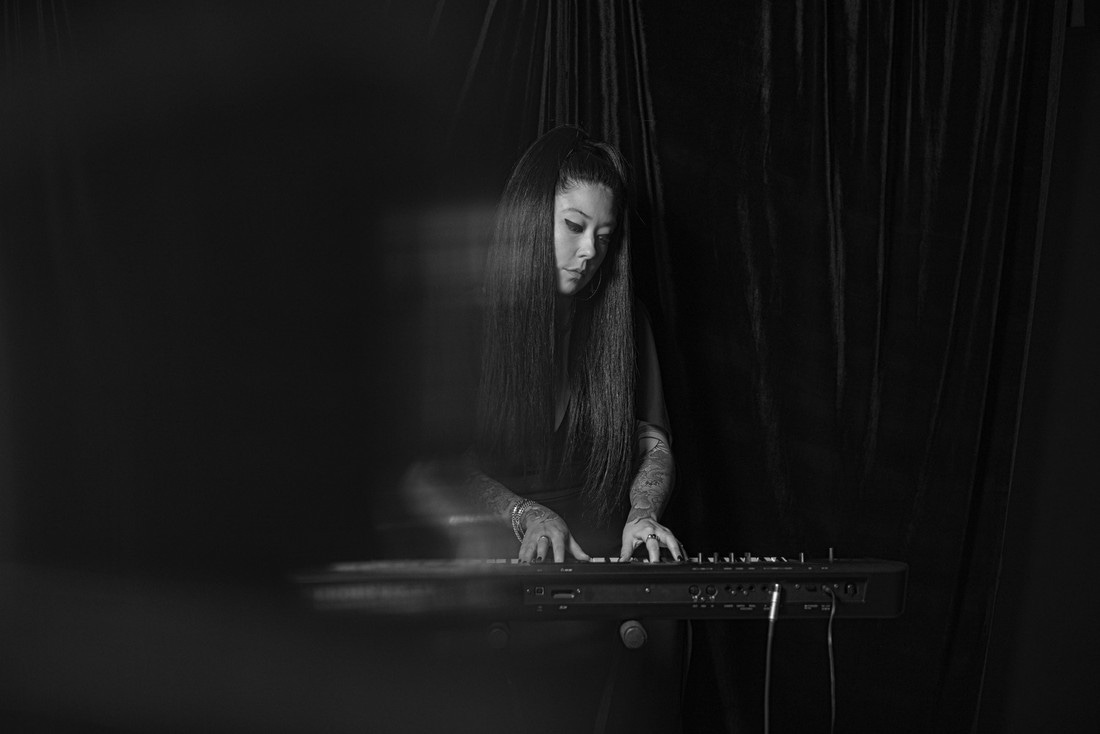It’s easy to recommend The Night Terrors and get people interested - it’s the band with the theremin! But at the same time, that’s also a reductive to look at them, as it seems to imply that they’re a sort of novelty just because they use a weird instrument, and that couldn’t be further from the truth. Sure, yes, the theremin is at the center of everything the entity created by Miles Brown does, and on the new record in particular, it’s like the vocalist of the band, to put it that way. Still viewed as a mysterious, almost esoteric device - not only the first electronic instrument, but one that is played without any physical contact between it and its performer -, it also has an inherently spooky, ghostly, otherworldly sound. So when you have a band that deliberately sets out to explore those moods, you are sure to have a very out-there kind of listening experience. But that’s not all, and there’s a reason why we haven’t had a deluge of “theremin prog” or whatever (theremincore! Can you imagine?) in the last decades.
Firstly, because it’s not everyone that becomes a thereminist out of the blue. Miles is an absolute master of his craft, having studied with Russian theremin queen Lydia Kavina, and having performed with the likes of Lou Reed, Laurie Anderson, Goblin, Black Mountain, Mick Harvey, Alexander Hacke, Danielle de Picciotto or Bardo Pond, among others. He is involved in dance music, sound art, analogue electronics, and also film scores and live ballet performances - he’s contributed theremin to the soundtrack of Australian horror movie ‘Late Night With The Devil’ (2023), and has performed live scores for Natalie Abbot’s giallo ballet ‘(re)PURPOSE: the MVMNT (2017)’.
Personally, I discovered The Night Terrors on an extreme metal festival, of all places, over a decade ago, where they appeared mostly because they were supporting fellow Australian band Heirs (remember them? They seemed like the next big thing when ‘Fowl’ came out but then disappeared off the face of the planet) on an European tour that happened to go through that festival. Also, even in the unlikely event that you become a master thereminist, or at least a capable one, you still need to apply that to songwriting, which is where Miles and The Night Terrors truly shine. With a particular talent for building evocative, elusive sound landscapes that feel like they’re swirling caleidoscopic images within your mind (especially when coupled with synths, as is the case with this new release we’ll talk more about in a second), but at the same time exhaling a sinister, nocturnal ambiance, they’re a band that builds actual songs with a meaning, a direction, a vibe, all to themselves, rather than just fiddle around with a cool weird instrument and just rely on the novelty of that to succeed.
As a result, they sound like absolutely no one else - one vague point of reference I could give is the equally amazing, though theremin-less, Pinkish Black, and the moods of some of those old horror soundtracks (like, indeed, the ones by Goblin), but nothing specific that could fully prepare you for this. Thouch the music is deep and layered, their impact is usually immediate, too. Ten minutes into that show where I discovered them and I had already decided to get everything they might have at their merch stand, which included their new album at the time, the still astounding ‘Back To Zero’ which is heavily recommended if you don’t know it. I was lucky enough to meet Miles at said merch stand and talk to him a bit, and I’ve been a big fan ever since.
Which is why I was extremely happy when I managed to get my grubby paws on the new The Night Terrors album. It’s been a while, you see - even if Miles has had a couple of fantastic albums under his own name since, including my favourite ‘The Gateway’ -, but ‘HYPNOTICA - Composition for Theremin and Electronic Music Synthesizer’ effortlessly brings the band out of their little hiatus and absolutely fully delivers as if they were never away.
In the company of fellow Australian Sarah Lim, who handles the synths, the album sure does what it says on the title and so much more besides. Each The Night Terrors album seems to be an entire experimental universe onto its own - the last one, ‘Pavor Nocturnus’, was focused around a pipe organ performance, as the band had been commissioned to compose an album of music with the Southern Hemisphere's largest Grand Pipe Organ. The darkwave-y ‘HYPNOTICA’ is all about the marriage of theremin and synth, and the result is brain-twistingly incredible, as cinematic as it is shadowy and distant, as scary as it is strangely enveloping and yes, quite hypnotic, of course. With the first four and the last four songs divided in two sides, Side I - Descent and Side II - Ascent, it offers plenty of meaning for you to try and decode, and I’ll guarantee you’ll have a blast doing it.
As always, Miles has been wonderfully nice and available, and he granted The Devil’s Mouth the pleasure of a little chat, so hang around to discover more about the weird and wonderful world of Miles Brown and The Night Terrors, right after the jump.
‘HYPNOTICA - Composition for Theremin and Electronic Music Synthesizer’ is now out on Disdain Records.
You can find The Night Terrors on Bandcamp, Instagram, Facebook and Spotify.
“We like to be a bit provocative and step away from trends in the genres we are considered to inhabit. So maybe the heaviest thing to do at this point was to make a dreamy drugged-out woozy dream music.”
— Miles Brown
It’s great to have The Night Terrors back! Your last couple of releases have been under your own name – what made you recover the “band” for ‘Hypnotica’, and what are the origins of the idea for this release?
Miles Brown: Hi José! It’s great to be back, thanks for having me on. Yes it’s fun to have the band reanimated after such a long break. We really only went on hiatus because all of us became busy with other projects. We released two albums in 2014 just as some of our other projects were kicking off. Our drummer was touring overseas with two other bands, and tour managing lots of others. I had always wanted to develop a solo theremin project, as there had been so many instances when great opportunities arose that the band had to turn down due to availability. Also the creative process for the band had become essentially solo, and I felt there were some musical ideas coming together that didn’t really fit the Night Terrors project.
Our last album ‘Pavor Nocturnus’ was centred around the pipe organ, and we had initially planned to try and tour venues around the world with pipe organs, but quickly realised this was a tough proposition logistically as most organs are in churches or municipal spaces, and the people who manage those places weren’t necessarily into our kind of music. We did end up playing quite a few churches and very quickly ran into issues with people assuming we were Satanists. Apparently the combination of theremin and organ is obviously occult to some (usually conservative) people! So the band kind of went on pause, and then our other projects got busier. I got really into the gothic Italo horror disco theremin party music thing, made a couple of albums for Death Waltz and started playing more in club land, which was fun and very different.
The material for this album started off as a collection of things as I writing that didn’t fit the high energy solo project. I went to Berlin to soak up some fun industrial techno vibes and write some bangers, and was surprised that what came out over there was this more melancholy ethereal stuff, which was more reminiscent of the quieter aspects of The Night Terrors records. It seemed like time to explore that particular vein of our music a bit more.
Through our pipe organ experiences I had started thinking about ritual music and how it functions as a medium for emotional processing. The theremin can often be considered a musically difficult instrument, but to us it seems very at home in these extraordinary spaces around these big feelings. So the concept for Hypnotica came together as a sort of musical requiem.
Was Sarah involved in the writing too? How is it like, to have the synth and the theremin weaving sounds around each other so wonderfully like this, is it hard to write tor this duo of instruments or does it feel natural?
Miles: Sarah was a great sounding board for me during a weird creative time in the world that kept us apart (lots of the album was made in COVID lockdown) and reinventing ways to create together.
It feels pretty natural to write for this duo having a firm understanding of both instruments and where they need to sit melodically and sonically for them to work and not take over each other in each piece. I also just love synths and for this record found a really congruent combo of instruments in the studio that were highly inspirational.
On our previous albums we’ve always created progressive electro rock sound worlds and then added the theremin like a vocalist on top. On ‘Pavor Nocturnus’ we obviously created the record around unique voicing of the pipe organ. On this new album I really wanted the theremin to be the central focus, and to demonstrate the huge emotional and dramatic capacity of the instrument. The theremin has always been our lead vocalist, so I guess we wanted to give it its diva moment. Also some music people still consider the synthesiser to be cold and unemotional, so we wanted to explore what was possible with analogue electronics in this realm.
What is actually your writing method, at least for The Night Terrors? Does it always start with you dabbling away at the theremin? Do you usually have a previous mood or idea, or even something more specific, when you start the writing process?
Miles: The writing process for Night Terrors has become more thematic and conceptual over the years, and I guess that prog ‘concept album’ has always lurked around in the background. I’ve wanted to explore the theremin as a lead voice in music ever since I first heard the soundtrack to Tim Burton’s film ‘Ed Wood’ (composed by Howard Shore and featuring my teacher Lydia Kavina on theremin). In many ways our band has existed to provide that musical space, as it’s not something many people would usually attempt due to how hard it is to play theremin in a loud band context. As playing theremin is so reliant on auditory feedback, a lot of writing for the instrument is about creating a sonic landscape that has enough identifiable melodic information to pitch the theremin to. If that’s not there it can be kind of like feeling through a dark room without enough light.
Theremin has been used so much as a spooky sound effect or out of control glissando musical presence in the past, and I’m far more interested in taking into new less obvious places that challenge peoples perception of where it belongs in music. So I guess it’s about developing opportunities for our ghostly operatic ‘lead singer’ to express themselves and grow musically. Playing theremin is very intense and meditative, and sometimes if you get into a deep flow state it can feel like someone else is playing with your hands. So I guess these days I’m trying to create a welcoming musical set for our otherworldly visitor to come and play in.
How would you describe this new album, both for newcomers to your music and for old The Night Terrors fans like yours truly who dug classics like ‘Pavor Nocturnus’ or ‘Back To Zero’, for instance?
Miles: I’d say this album is an expansion of the sad and pretty side of our previous albums, and a deeper dive into the synth world that we’ve always incorporated into our songs. Night Terrors albums have always been sleep-themed, and while our previous records may have focused more on nightmares and imaginary horrors, this one is more about real scary stuff, and the idea of sleep / sedation as an escape from reality. I like to shift the concept of the band slightly with each album, ‘Back to Zero’ was prog noise rock, ‘Spiral Vortex’ was flirting with the history electronic synth rock, ‘Pavor’ was more directly a horror soundtrack thing. This time we wanted to relocate to a more gothic dark wave context, where our vocal heroes like Lisa Gerrard, Kristy Thirsk and Elizabeth Fraser have found congruent musical space for their beautiful dramatic ethereal voices. Also on this one we were working in a purely electronic manner, and drum machines have always been a huge part of dark wave / ethereal wave records. I think also we like to be a bit provocative and step away from trends in the genres we are considered to inhabit. So maybe the heaviest thing to do at this point was to make a dreamy drugged-out woozy dream music. Having said that, the music we are working on now for the next record is going to be some of our heaviest ever. We like to switch it up, and the great thing about writing original contemporary theremin music is there are no rules!
“People often joke that a beginner violinist sounds like a dying cat, if that’s true then maybe a beginner thereminist sounds like a cat that has already died.”
It’s unavoidable to ask about your instrument, as it is still such a curious and unusual one, especially within “dark” music such as what you do. How did you first get into the theremin? What is the typical learning curve once you start to get to grips with it? And is there a strong community of thereminists, someone you admire in particular or that you’d like to recommend?
Miles: I first got into theremin through my dad who was an electrical engineer, musician and massive prog rock fan. I had always loved the analogue synth / Moog stylings of bands from his record collection such as Yes, Mahavishnu Orchestra and The Cars, and was listening to more Moog related stuff as a teenager. My dad told me that there was an instrument that came before the synth, that was played without being touched. I was intrigued so we looked it up online, and as soon as I heard the incredible sound of Clara Rockmore playing theremin, I was hooked. What an incredibly beautiful and deeply melancholy musical voice! Dad had the plans to build a theremin from a 70s science magazine, so we built one out of cake tins, spare electronic components and workshop castoffs. This instrument was a weird circuit bent dual pitch theremin that I used in my teenage grunge band (in breaks from playing bass) and it all kind of developed from there.
Theremin is very hard to master, because there’s no fretboard or keyboard, just the relationship between your body and the electromagnetic field around the instrument antennae. Back in the late 90s there weren’t very many resources to learn. I kind of taught myself, grabbed the few video resources that existed featuring Lydia Kavina and Clara Rockmore, and generally sucked at it for a long time, at least the first ten years. When the Night Terrors got more serious I realised I really need to skill up to achieve the musical goals I had in my head, so I started looking at study options. I heard that the great theremin virtuoso Lydia Kavina (herself a relative of and taught by Leon Theremin, the inventor of the instrument) was giving masterclasses in Europe so I enquired about attending one. Lydia wrote back and very generously offered to take me on for private tuition, so I travelled to Oxford in the UK and spent a few months learning from her. This was huge for me, and I was finally able to start learning the real craft of playing the weird instrument from the source. Lydia taught me the aerial fingering techniques, strict body and attentively control required to stand very still and express musically through the instrument. I also learnt that if a thereminist is tired, hungry, hung over or distracted, you can hear it in the music. If you breathe wrong, shift your posture, or have shaky hands, the audience can hear that too. So I had to change my lifestyle as well as my attitude. This requirement of intense stillness and bodily was control a big shift from my life as a hard partying rock bassist, where looseness, brute force and moving with the music are so important. Where a rock muso might achieve a ‘higher state’ through artificial means, the theremin requires a different kind of meta state transference. I also learnt about the conceptual and philosophical side of playing theremin, which I absolutely loved. In many ways it’s a lifestyle as much as an instrumental specialty, if you really want to get into the upper realms of performance it requires a pretty big commitment of discipline, maturity, time and energy. For me the rewards are more than worth the work.
The professional theremin community is quite small worldwide, and the subsection of those players who create new original music for the instrument is smaller still. I have some big theremin heroes: Pamelia Stickney (previously Pamelia Kurstin) is an absolutely mind blowing player who has created some incredible music in the experimental jazz / contemporary classical world. Carolina Eyck is a world leader and totally amazing, playing wild original music and both solo and in collaboration with other genius classical and electronic musicians. Lydia Kavina is utterly astounding and her classical and soundtrack recordings are mammoth and very inspirational. Thorwald Jorgensen is a completely awesome sensitive classical player, I love his latest CD.
And of course you can’t go past the grand OG theremin goddess Clara Rockmore, all her classical recordings are knock-yourself-out amazing and an endless source of inspiration for me.
There’s this fantastic quote from the album’s description on Bandcamp, which refers to the theremin as “a transcendent musical medium for the processing of universal heartbreak and the expression of contemporary existential terror.” I wonder why more people haven’t discovered the haunting capabilities of this instrument in that context. Are there any “disciples” of yours that you might know that have started to do something similar to what you do? Have you felt your influence in any other musicians or bands?
Miles: I think people often sideline the theremin as a difficult musical proposition and as a spooky novelty. Also so many people have been burnt by hearing the instrument played badly. Anything in a musical sense that is a struggle to listen to is a bad time for the listener. People often joke that a beginner violinist sounds like a dying cat, if that’s true then maybe a beginner thereminist sounds like a cat that has already died.
What I love about the theremin is also the hardest thing about it: it captures the mood of the player so nakedly. If you’re musically frustrated or struggling, your audience will hear it. The great side of this is that you can also capture a express a very delicate and complex range of other feelings with equal power. So sadness, yearning, fear, hope, love, melancholy and any conflicted combination of these emotions can also register with the listener. In many ways it’s as expressive as a human voice. Our brains are super good at identifying feelings in the voices of others and I think it’s connected somehow to that process.
Regarding other artists who have taken influence from us, I’m not really sure. I do know there are very few acts releasing original contemporary records with theremin as a lead instrument in the world, I wish there were more!
What are your touring plans, if any? It would be great to have you back in Europe again!
Miles: We are planning tours of Europe, USA and Australia right now. We haven’t actually toured at all since ‘Spiral Vortex’ and ‘Pavor’ came out, so we have three albums of material to play for everyone outside of Australia. I’m really looking forward to getting on the road again, it’s been way too long!
Will you keep releasing things both as Miles Brown and as The Night Terrors? Is there any other project you might have in the works? What do your next years look like?
Miles: Yes I have a new solo album very close to completion, and another following very closely behind that. Also we’re quite a long way into writing the next Night Terrors album, we definitely won’t wait 9 years between records again.
I also have a new project called The Narcoleptor which is a wild avant-goth collaboration with experimental harpist and vocalist Mary Doumany. We’ve released a couple of records and have more coming out soon, so I’ll be touring with that too. There are also some fun new collab projects on the boil, and more records associated with those as well. So lots of theremin action in the next few years!








